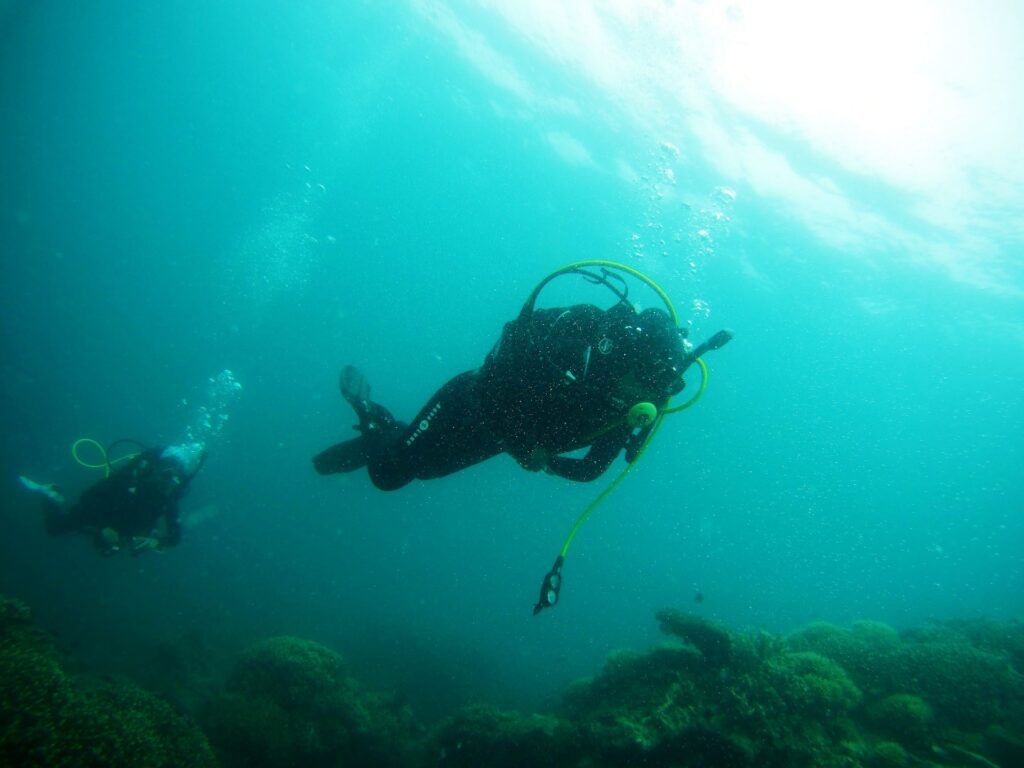How Does A Buoyancy Control Device Work?
Lauren Collison September 26th, 2023 Posted In: Articles Tags: SCUBA
Buoyancy Control Device (BCD): Your Gateway to Weightless Exploration Underwater
Imagine gliding effortlessly through the crystal-clear waters of the ocean, observing vibrant coral reefs, and diving by exotic marine life. Achieving this seemingly weightless experience underwater is made possible by a pretty awesome piece of SCUBA diving equipment known as the Buoyancy Control Device (BCD). We’ll explore what a BCD is as well as answer the question of ‘How does a buoyancy control device work?’. And we will explain its crucial role in enhancing the safety and enjoyment of SCUBA diving adventures.
What is a Buoyancy Control Device (BCD)?
A Buoyancy Control Device, often referred to simply as a BCD, is a fundamental piece of diving equipment. It’s designed to help divers maintain neutral buoyancy underwater. Neutral buoyancy is a state where the diver neither sinks nor rises but hovers effortlessly in the water column. Achieving and maintaining neutral buoyancy is essential for several reasons:
- Safety. Proper buoyancy control ensures that divers can avoid unintentional ascents or descents, which can lead to barotrauma or decompression sickness.
- Conservation. Neutral buoyancy minimizes contact with the fragile underwater ecosystems, reducing the risk of damaging marine life and delicate coral reefs.
- Energy Efficiency. Divers expend less energy when they can maintain a steady position in the water, allowing for longer and more enjoyable dives.
How Does a Buoyancy Control Device Work?
To comprehend how a BCD functions, it’s essential to understand its components and their roles in maintaining buoyancy control.
The BCD Vest
The central part of the BCD is the vest-like structure that the diver wears. This vest consists of an inflatable bladder made of durable material, typically nylon or polyurethane. The bladder is connected to an inflator mechanism with a low-pressure hose that allows the diver to control the amount of air inside the bladder.
Inflator Mechanism
The inflator mechanism is usually located on the diver’s chest or shoulder and includes a button or lever that can be operated easily even while wearing thick gloves. When the diver presses this button or lever, it releases a controlled amount of air into the bladder, inflating it.
Deflator Mechanism
In addition to the inflator, the BCD also has a deflator mechanism, which allows the diver to release air from the bladder. This is typically done by pressing a separate button or pulling a cord, depending on the BCD’s design.
Integrated Weight System
Many modern BCDs come equipped with an integrated weight system. Instead of wearing traditional weight belts, divers can place their dive weights in pockets integrated into the BCD. This feature enhances comfort and streamlines the diving experience.
Tank Strap
The BCD also has a tank strap or harness that securely holds the SCUBA tank in place on the diver’s back. This strap ensures that the tank’s weight is evenly distributed, helping to maintain balance and buoyancy.
D-Rings and Accessory Attachments
BCDs are often equipped with D-rings and attachment points for various accessories such as underwater cameras, dive knives, and lights. These attachments provide convenience and versatility during dives.

How Buoyancy Control Works
Now that we’ve covered the key components, let’s dive into how a BCD facilitates buoyancy control.
1. Buoyancy Adjustment:
Before entering the water, divers add air to the BCD’s bladder through the inflator mechanism. This initial inflation helps maintain positive buoyancy at the surface, making it easier to float while preparing for the dive.
2. Descending:
As divers descend, the water pressure increases, causing the air inside the BCD’s bladder to compress. To counteract this compression and maintain neutral buoyancy, divers periodically add small bursts of air using the inflator.
3. Neutral Buoyancy:
The goal is to reach a point where the amount of air in the BCD’s bladder is balanced with the diver’s weight, allowing them to hover at the desired depth with minimal effort. Achieving neutral buoyancy ensures that divers neither sink nor rise in the water.
4. Ascent:
When it’s time to ascend, divers release air from the BCD’s bladder using the deflator mechanism. This gradually reduces their buoyancy, allowing for a controlled ascent.
5. Safety Stops:
During safety stops, typically performed at shallower depths towards the end of a dive, divers can fine-tune their buoyancy by adding or releasing small amounts of air to remain at the required depth.
6. Emergencies:
In case of an emergency ascent, the diver can quickly release all the air from the BCD to achieve positive buoyancy and rise to the surface rapidly. This is a crucial safety feature to prevent underwater accidents.
How a Does a Buoyancy Control Device Work: Final Thoughts to Keep You Afloat
In the realm of SCUBA diving and SCUBA diving gear, the Buoyancy Control Device provides the means to master the art of buoyancy control, enabling safe and enjoyable underwater exploration. By allowing divers to hover effortlessly, conserve energy, and protect fragile marine environments, the BCD plays a pivotal role in elevating the world of diving to new depths of wonder and discovery. Whether you’re a novice or an experienced diver, investing in a reliable BCD is a step towards unlocking the magic of weightless exploration beneath the waves!

